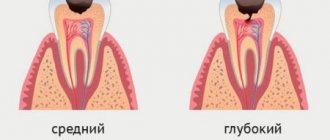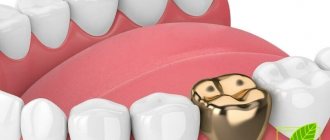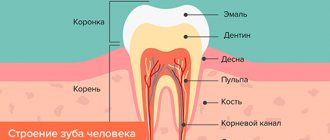There are many myths surrounding the concept of “bad bite”. Many believe that the position of teeth can only be corrected in childhood, the anomaly causes only aesthetic problems, and dental clinics only have braces at their disposal. Is it so? Let's figure it out.
Bite – the arrangement of the teeth when the jaws are closed. With a normal bite, each upper tooth is in contact with its lower “antagonist”, the dentition is even, there are no gaps.
You can correct the position of your teeth not only during the period of active growth. Of course, the easiest way to do this is in childhood. However, it is quite possible to eliminate the anomaly in adulthood. For this purpose, not only brace systems are used, but also various surgical methods, as well as microprosthetics.
It is important to understand that the success of orthodontic procedures depends on the condition of the teeth, the type of bite and the degree of pathology. The stronger the anomaly, the more difficult it will be to correct it.
Types of bite
There are several types of correct and incorrect bite.
The types of correct (physiological) bite include:
- straight;
- orthognathic;
- physiological prognathia;
- physiological opistognathia.
These types of malocclusions are widespread and do not lead to any problems with teeth or overall health.
There are more varieties of abnormal, pathological bite:
- distal. Characterized by a large sagittal fissure (from 6–9 mm). The teeth of the upper jaw protrude strongly forward. Most often, genetic predisposition is to blame for this type of bite. Possible reasons lie in the early removal of lower primary teeth, bad habits, etc.
- deep bite In this case, the front teeth of the lower and upper jaws do not touch at all - the upper jaw completely “overlaps” the lower one. Most often, such a bite occurs due to different sizes of the upper and lower front teeth, early removal of baby teeth, and bad habits.
- open bite. With this anomaly, the front or lateral teeth on the lower and upper jaws do not touch each other. The jaws do not close completely. Very often, such a bite appears due to sucking a pacifier or thumb in childhood, the habit of breathing through the mouth, and for other reasons.
- mesial. In a mesial dentoalveolar bite, the lower incisors protrude forward and the lower incisors protrude backward. With a gnathic bite, the upper jaw turns out to be smaller than it should be with a normal bite, and the lower jaw is larger.
- crossbite. In this case, the teeth on the upper and lower jaws do not match each other in size and shape, grow incorrectly, and the jaws do not close completely. Such a bite, in addition to heredity, is caused by bruxism, rapid loss of baby teeth, swallowing problems and other reasons.
- edentulous Part of the teeth (usually the lateral incisors) are missing, as a result the jaws are formed incorrectly, and the spaces between the teeth may increase. The causes of edentia have not been precisely established: these may be disturbances in embryonic development, heredity, or illnesses of the mother during pregnancy.
- crowding. This anomaly is common and is characterized by the incorrect position of the teeth on the jaws. They are located too close to each other and grow unevenly. In the past, treatment was limited to the removal of quarter premolars. Today, in 70% of cases this can be avoided.
- diastema and trema. This phenomenon is the opposite of crowding: the teeth are too sparsely spaced, there are gaps between them (three spaces - between the lateral teeth, canines, diastemas - between the front teeth).
As you can see, there are many types of pathologies, and each case requires special treatment.
Methods of therapy for correcting bite
Correcting a bite most often means exclusively wearing braces. Indeed, they are often used (and not only for children), but other methods are also used in orthodontics. They can be divided into two groups - surgical and non-surgical.
Surgical methods
Surgical intervention is necessary in three cases:
- when there is high crowding, when it is necessary to remove quarter premolars to make room for other teeth;
- with serious jaw abnormalities;
- to speed up treatment.
Severe pathologies of the jaw bones, which lead to malocclusion and disturbances in swallowing and breathing, cannot be corrected without surgery. During the operation, the surgeon cuts the bone tissue in the places where the teeth need to be moved. At this time, the patient is under general anesthesia in the inpatient department. Rehabilitation after surgery takes up to three weeks. After the tissues are restored, the jaw will have to be developed. Most often, additional treatment is required: the doctor prescribes braces, which must be worn for at least six months. The type of braces, duration of wearing them, and location depend on the current state of the bite.
Surgery can also be used to shorten the treatment time for malocclusion. Orthodontists use what is called a corticotomy, a small operation performed after braces are installed.
About a week after installation, the patient comes to the periodontist, who uses a piezotome to make small incisions in the gums. The entire operation takes about 30 minutes and is performed under local anesthesia. Occasionally, sedatives are also used - general anesthesia is usually not needed.
After corticotomy, the patient will have to visit the orthodontist and periodontist several more times to remove sutures, monitor the condition of the gums and correct the braces. The operation significantly speeds up treatment – by 3–6 months.
Important: surgical intervention is prescribed only in adulthood, after the jaw is fully formed (usually after 16 years). There are a number of standard contraindications: HIV, cancer, heart disease, etc.
Treatment without surgery
If we are not talking about serious pathologies of the jaw, orthodontists and their patients do without surgical treatment methods. Correction of the bite occurs through the installation and long-term wearing of braces, mouthguards and other devices.
Braces are the most effective way to eliminate pathology. They are a power arch with brackets that are secured to the teeth. The arch provides constant pressure on the teeth, and they gradually move, taking the right place.
Braces are worn without interruption. They are removed only at an appointment with the orthodontist, during correction. Over the entire period of treatment (which ranges from 6 months to 3 years), several visits to the doctor may be required. The procedure and duration of treatment depend on the condition of the teeth and the chosen braces system. Thus, self-ligating ones do not require too frequent visits to the orthodontist.
In addition to braces, there are other methods of therapy. Thus, mouthguards are often used - removable devices made of transparent material, and if we are talking about three, microprosthetics (veneers) are chosen.
Preparing for treatment
Elimination of the defect requires a comprehensive examination of the oral cavity and selection of optimal treatment. In particular, the doctor assesses the size of the pathological holes. An x-ray examination is also prescribed, which allows you to identify the presence of hidden injuries. Regardless of the chosen scheme, before starting treatment of rare teeth, therapy for caries and other pathologies of the oral cavity is prescribed.
Self-medication is dangerous with complications!
Attention
Despite the fact that our articles are based on trusted sources and have been tested by practicing doctors, the same symptoms can be signs of different diseases, and the disease may not proceed according to the textbook.
Pros of seeing a doctor:
- Only a specialist will prescribe suitable medications.
- Recovery will be easier and faster.
- The doctor will monitor the course of the disease and help avoid complications.
find a doctor
Do not try to treat yourself - consult a specialist.
The most difficult operation to correct a malocclusion is implantation. Before it is performed, a panoramic photograph of the jaw is taken, which allows you to select the appropriate pin size.
Implantation is contraindicated in many cases. It cannot be used in the presence of oncological pathologies, tuberculosis, a number of chronic diseases and allergies to anesthesia. Implantation takes several hours. During the procedure, tooth extension is carried out in three projections: width, height and length.
After the operation, the patient should follow certain procedures for several months to prevent the development of complications.
Types and features of bracket systems
In the past, there were only metal braces - they were not aesthetically pleasing and caused some inconvenience. Today, a huge number of other devices are used for constant wear, and braces have become much more comfortable and aesthetically pleasing.
There are three classifications of systems, which are based on the installation method, mounting location, and material.
Types of braces according to the method of arch attachment
For adult patients, two types of stationary systems are used: ligature and self-ligating (ligature-free). To better understand how they differ from each other, you need to have a good understanding of the design of braces.
Braces consist of an arch and clasps that are located on the teeth. In ligature systems, the clasps are attached to the arch using special rings - ligatures. In self-ligating rings, such rings are not used - the arcs are inserted into a special groove.
Ligature braces
Ligature bracket systems have a classic design and have proven their effectiveness in various pathologies. They will ensure the correction of the bite in the shortest possible time, if we are talking about a relatively strong displacement of the teeth.
Such systems also have a drawback: the patient will have to come to the orthodontist every month for correction.
Self-ligating systems
Ligature-free braces have two key advantages: they are much more aesthetically pleasing and save the patient’s time. You will have to visit the orthodontist every one and a half to two months, and not monthly, as is the case with ligatures.
There is another advantage: such braces provide gentle but constant pressure on the teeth.
Types of braces according to installation site
Classic braces have always been installed on the outside of the teeth. However, in recent years, systems have appeared that can also be worn from the inside. Let's take a closer look at each type.
Vestibular (external) bracket systems
This is a classic version of the system: such braces are located on the outside of the dentition and are visible from the outside. Despite some damage to aesthetics, they are chosen most often due to their high efficiency and relatively low cost.
Lingual systems
Lingual or internal braces are much more aesthetically pleasing. They are simply not visible from the outside: all elements of the system are located on the back side of the dentition.
Lingual systems are more expensive and require some getting used to: they affect diction. However, if you work with people all the time, have a slight malocclusion, and don't want others to see your braces, you can use this option.
Types of braces by material
Once upon a time, only metal braces were available, and many who wanted to correct their bite were embarrassed to go to the orthodontist and wear braces for several years. The situation has changed: now the range of braces has expanded, and they began to be made from different materials - from traditional metal to ceramics and even sapphires. The appearance of the systems has also changed - now they look much more aesthetically pleasing and even look like decoration.
Metal bracket systems
These are inexpensive, fairly effective and reliable systems that have gained maximum popularity. Most often, such braces are made of medical steel - it does not cause irritation or allergies, and does not react with saliva and acids that may be in the oral cavity.
In addition to steel systems, titanium systems are used - the most durable and eliminate any reaction in the oral cavity, as well as gold. Gold braces are aesthetically pleasing and effective.
Plastic braces
This is the first type of system to appear as an alternative to metal braces. Plastic systems are aesthetic, almost invisible on the teeth, and are inexpensive. They also have disadvantages: low strength and the possibility of coloring. The first can be eliminated only by completely changing braces, the second can be eliminated by choosing colored systems.
Ceramic braces
Ceramic onlays on the teeth are difficult to notice and provide a good hold. However, like plastic ones, they can collapse under mechanical stress. Coloring is also possible - after strong tea, coffee, cherry juice, red wine.
Sapphire braces
Such systems are made from aluminum oxide. They are almost invisible on the teeth, and in terms of strength they are comparable to ceramic braces. Unfortunately, they also have a drawback - high cost.
Combined bracket systems
Doctors often choose combined braces. They combine the aesthetic appearance of ceramic structures (on the visible upper jaw row) and the strength of metal ones. Also, such designs are relevant if you need to create different tension on the teeth.
Plus this is due to:
- reasonable price for the patient;
- effective and short-term treatment;
- ability to correct complex cases.
The cost of braces: a brief overview
Of course, it is impossible to give exact prices at the moment: the cost of all braces, as well as dental services, is gradually increasing. In addition, the final amount depends on the condition of the teeth and the final design of the braces. But general information can be provided.
The most affordable braces systems are classic ones, which are classified as ligature, are installed on the outside of the teeth and are made of medical steel. Their cost ranges from several thousand rubles. Plastic systems of the same type cost approximately the same.
Ceramic ones will be more expensive - the bill will already be several tens of thousands of rubles. Sapphire ones will be slightly more expensive. Titanium and gold cost even more due to high prices for materials.
However, the cost is affected not only by the material from which the braces are made. In particular, you will have to spend at least 40 thousand rubles on non-ligature systems, even if they are created from ordinary medical steel. The reason is a more complex design and high requirements for the product. The same applies to lingual systems: they must be much smaller, but must provide the same fixation and pressure as conventional vestibular braces. Their cost can exceed 100 thousand rubles.
More accurate information on prices can be found by going to the price list section, or by contacting our manager by phone.
How much does a perfect smile without gaps between teeth cost?
A perfect smile without gaps requires, first of all, a lot of patience and a little trust. Material costs depend on your choice and on the country where you want to be treated. Non-EU countries widely practice dental tourism, offering very competitive prices.
Braces, for example, in our clinic are not at all expensive (from 550 euros to 750 euros), you need to come to Moldova for adjustments. This is why we recommend that you evaluate how rational or economical the entire treatment will be.
Ceramic veneers cost 225 euros per tooth. Their advantage is that the treatment is carried out in one stage, which makes it very attractive to people abroad. To prepare teeth for EMAX ceramic veneers, we use a microscope and other magnifying devices, which makes the preparation (grinding) imperceptible, but the end result will surprise you to tears.
Correcting a bite without braces: is it possible?
Braces remain one of the most effective ways to correct an overbite, even if you begin treatment as an adult. But if we are talking about small deformations, the use of stationary systems may be redundant. In some cases, you can get by with removable systems – aligners, trainers. In others, you can even use veneers - they will not change the position of the teeth, but will improve their appearance.
Veneers: are they worth using?
Veneers are special coverings that cover the front teeth and provide an aesthetic smile. Installation of veneers refers to microprosthetics. This procedure will not change your bite, but will help make your teeth more beautiful and straight without long-term treatment. Veneers are an ideal choice if you have:
- teeth are irregularly shaped and have different sizes;
- Due to the small size of the teeth, there are diastemas and tremata.
You can get veneers based on your orthodontist's recommendation. Like other prostheses, they are made from individual casts, but installation does not require lengthy preparation. In some cases, this is the only way to remove an aesthetic problem.
Aligners and trainers
Removable structures are used for minor or moderate anomalies that do not require the installation of a brace system. Both adults and children can wear aligners and trainers.
Trainers “work” as a kind of simulator. They ensure proper functioning of the jaw muscles and almost eliminate mouth breathing. Gradually the patient gets used to chewing and breathing correctly, and the teeth straighten.
Aligners or aligners are a transparent silicone shell that can be removed and put on at any time, without the help of an orthodontist. Aligners provide pressure on the dentition and gradually straighten it. In order for them to affect the position of the teeth and help correct the bite, they must be worn almost all the time - up to 22-24 hours a day. You can remove your aligners if you are concerned about losing or damaging them (for example, while exercising or swimming).
Trainers and aligners are more convenient than braces and do not require special care: it is enough to keep the aligners clean and brush your teeth in a timely manner. They, like other devices, are made individually, and you will have to visit the orthodontist regularly - the mouthguard needs to be changed from time to time.
What is the disadvantage of rare teeth?
First of all, it is difficult to call rare teeth beautiful. They don't look aesthetically pleasing. This factor weighs heavily on many people.
In addition, due to rare teeth, the health of the gastrointestinal tract may deteriorate. After all, while eating, it is not possible to chew food thoroughly.
A number of rare teeth are not as strong as healthy ones. They are easy to injure and become infected.










